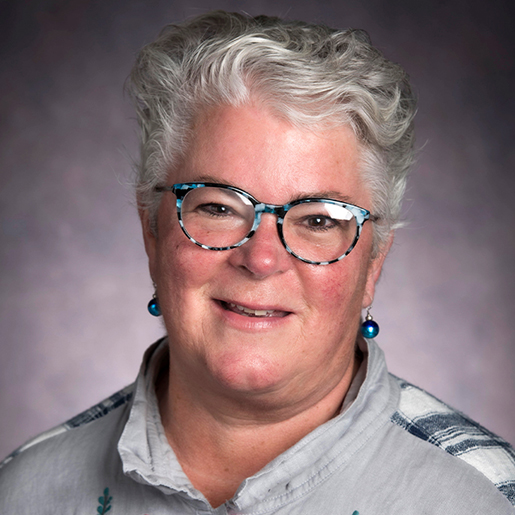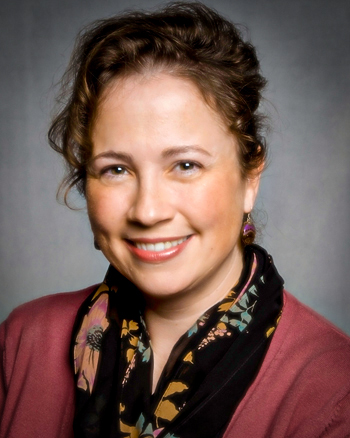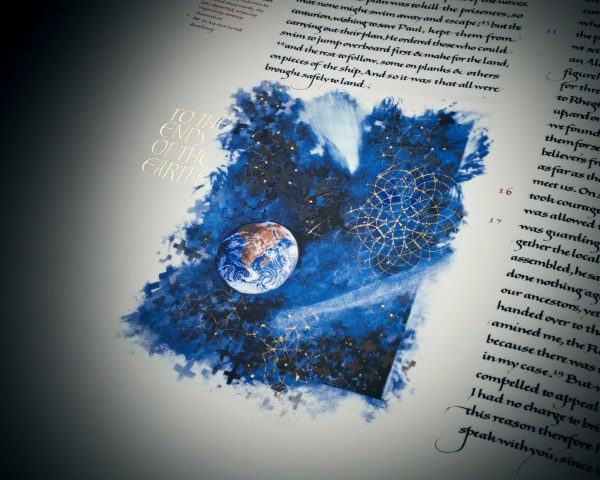Maureen Briare Composes a Cosmic Hymn for the University of Portland
Inspired by the infinite beauty of the “To the Ends of the Earth” illumination in The Saint John’s Bible, University of Portland pastoral musician and Chapel Choir conductor, Maureen Briare, composed a celebratory hymn in its name to say goodbye to graduating classes as they leave university for adulthood.
Portland, Oregon People often experience art and faith in similar ways. Both ignite a sense of spiritual awareness and creativity within oneself. The Saint John’s Bible is no exception, inviting seekers to explore faith from a new perspective.
One illumination from this sacred work of art, titled “To the Ends of the Earth” depicts swirling, cobalt blue cosmos that envelope a radiant planet earth. Written in golden ink, the words “To the Ends of the Earth,” float across the page. The phrase is a reminder of the eternal, the limitless nature of love, and of the universe beyond what we think we know. This message specifically caught the attention of Karen Eifler, Professor of Education and Director of Garaventa Center for Catholic Intellectual Life and American Culture at the University of Portland.

The University of Portland acquired one seven-volume set of The Saint John’s Bible Heritage Edition in 2013. As a docent for the Bible, Eifler continually looks for ways to deploy it in the University’s life and culture on campus.
“To the Ends of the Earth” is one of Eifler’s favorite illuminations. She feels the piece is what an image of infinity would truly look like that is, if one could materialize infinity as a work of art. This idea that Eifler held so close to her heart, served as the inspiration for the creation of Maureen Briare’s luminous hymn by the same namesake as the illumination.
“The illumination’s message just seemed to me like the perfect way to send off a graduating class – to recall that we’re loved to the ends of the earth,” said Eifler. “We’ve always had a traditional hymn to start the school year, but we’ve never had a hymn to end the school year at our big, baccalaureate mass. I knew this would be the perfect occasion for a hymn inspired by an illumination from The Saint John’s Bible, and Maureen would be the perfect person to write it.”

Maureen Briare, pastoral musician and composer at the University of Portland, was an easy choice when deciding who would compose the hymn. Admired for her virtuosity and imagination, Eifler chose Briare because she trusted her entirely. Eifler also chose Briare for her keen understanding of the charisms of the Congregation of Holy Cross whom the University of Portland’s campus ministry is governed by.
“I wanted us to have a signature piece for the University of Portland that would be unique and would do justice to that particular illumination,” said Eifler. “For my friend Maureen, who’s really making a name for herself in the world of pastoral music, I knew that this was the perfect project for her to undertake.”
Bringing Sound “To the Ends of the Earth”
Maureen Briare graduated from the University of Portland with a degree in the science of nursing, and later obtained her master’s degree in music with an emphasis on liturgical composition. Briare has worked in the campus ministry since 2000 and has enjoyed conducting the Chapel Choir.
Throughout Briare’s life, music and faith have always been intertwined. Briare owes the beginning of her musical endeavors to Sister Rebecca Mary from her fourth grade classroom, who gave her some of her first lessons on the guitar. Later, Briare learned how to play the piano and then the harp, which is her favorite instrument.
“Music transcends us from our presence or physical being. It opens our mind and heart by using our very breath, our skills, our hands. I think music is so embedded in our human nature,” said Briare.
“To the Ends of the Earth” is an illumination that speaks directly to this idea of transcendence. From the vantage point of the cosmos, one may contemplate faith beyond our physical realm, as the profound imagery and message speak to the vastness of the universe. Now, Briare has taken this inspiration and given the illumination life in a new plane: sound.

“When I was creating the music for the hymn, I felt it was designed for a community to play it and sing it,” said Briare. The hymn was intentionally composed to be adaptable to groups of musicians of all sizes, so musical communities small and large can perform the hymn. The result is joyous, optimistic, and full of movement.
“It’s the biggest, most ornately orchestrated piece that I’ve ever composed. It takes a community to play it. It includes hand bells, timpani, brass, strings, and woodwinds. It is designed that way for a lot of people to be involved. I tend to love when lots of people can be included in the music, with a big choir and a blasting organ. It’s a piece that calls for action, like a rally, to bring hope to the ends of the earth. Calling for discipleship. It is definitely a composition that will get you moving,” said Briare.
Briare trusts her creative process, admitting that there is a hint of mystery to it. Musical composition in the form of hymns is an art form in and of itself, as there is a specific metric and rhyming pattern to it. She likes to start with the text and the words of the illumination, thinking about how the phrase “To the Ends of the Earth” makes her feel. Briare then transfers that into the music, trying to replicate and evoke that emotion.
“I try to encapsulate that feeling and bring that text to life musically. I first get an idea of a phrase, and then work from there in the pattern. For example, repeating: ‘To the ends, to the ends of earth,’ and then having an interlude in the formula will create a concertato a musical formula for bigger hymns that have a couple verses, an interlude, and then a big finale with a soprano descant,” said Briare.
From her experience, Briare knows when she is creating something truly magical. What she pays attention to is if a melody is catchy and easy to grasp. If Briare hears one of her six children humming her tune back to her, then she knows the music must be good.
Human Connection Without Bounds
The hymn “To the Ends of the Earth” made its debut in 2016 during a baccalaureate mass gathering. Karen Eifler, who is an alto singer in the Chapel Choir, first heard the hymn without the orchestra. However, once the choir and orchestra joined together to play the hymn for the first time, everything fell perfectly into place.
“To hear those big kettle drums playing the introduction and the trumpets on the final chorus it was spine tingling. It was beautiful. It was infinite. I mean, it just was everything I had hoped for,” said Eifler. “The seniors for whom it was composed absolutely loved it. It felt like a love letter from Maureen to them. Parents who hear it absolutely love that message as they’re getting ready to send their kids off into adulthood from their University of Portland education.”
“It’s been really amazing to integrate music into the beauty of The Saint John’s Bible, and to meet people in different places where they can be nourished by that beauty,” said Briare.
The hymn “To the Ends of the Earth” is now officially published through GIA Publications. With the hymn now open to the public, Briare has built a true name for herself in pastoral music as an instructor, recording artist, composer, and harpist. She continues to spread her compassion and talent using musical language, pursuing her dream to integrate music and healthcare as a form of healing. Recently, Briare was offered a grant called Healing Strings, where she will be able to play the harp at different cancer clinics for patients receiving chemotherapy.
Art, music, scripture, healing, faith they are all interwoven in human experience. The Saint John’s Bible has proven its role in modern society as a gift that brings people together to admire its beauty and evoke questions to ask oneself: What do you see? What do you hear? How does it make you feel? “To the Ends of the Earth” offered these questions to Karen Eifler and Maureen Briare, and they have generously shared their discovery through the power of music, faith, and the embrace of infinity.
The Saint John’s Bible Heritage Program: Cosmic Imagination
To read more stories similar to this one, subscribe to the Heritage Program’s monthly e-newsletter, Sharing the Word, or visit the blog.
To read about the “To the Ends of the Earth” illumination’s trip to the International Space Station, click here.

